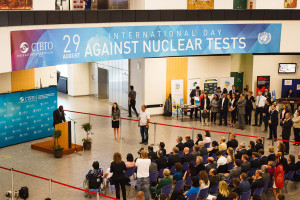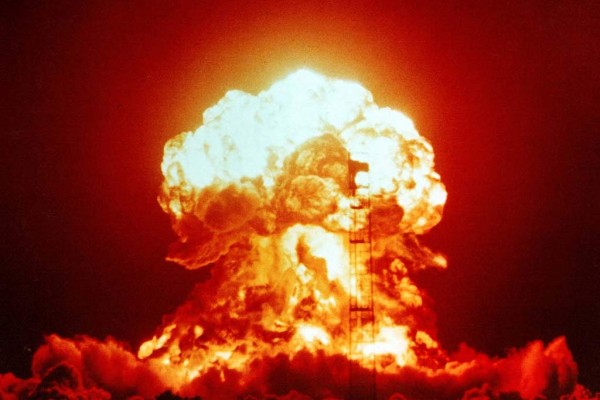United Nations officials on 10 September 2014 called for renewed commitment to a world free of nuclear weapons and nuclear tests, noting that nearly 2,000 such tests have taken place since 1945.
“Our collective aspiration for a world free of nuclear weapons must be reflected in a firm and formal commitment to ban nuclear tests,” Charles Thembani Ntwaagae, Vice-President of the General Assembly, said in a message delivered on behalf of President John Ashe.
“To test such weapons is to play with proverbial fire, takes us further down the treacherous path we seek to avoid and damages both human health and the environment,” he told the informal meeting convened by the Assembly to mark the observance of the International Day against Nuclear Tests.
Observed annually on 29 August, Day is meant to galvanize the UN, Member States, and non-governmental organizations to inform and advocate the necessity of banning nuclear tests.
The General Assembly resolution declaring 29 August as the International Day was initiated by Kazakhstan, which had closed its nuclear test site near Semipalatinsk on this date in 2009. Moreover, on the same date in 1949, the then Soviet Union conducted its first nuclear test, followed by another 455 nuclear tests over succeeding decades, with a terrible effect on the local population and environment.
Since nuclear weapons testing began in the mid-twentieth century, with the first test on 16 July 1945, nearly 2,000 have taken place.
Ntwaagae said that everyone can agree that there is no place for nuclear weapons in the future that Member States aspire to and in the global development agenda that they are currently mapping out.
“With their massive powers for destruction, the use of nuclear weapons would have catastrophic global consequences and would cause severe and long-lasting emergencies – humanitarian, global health, climate, social order, human development, and economic,” he stated.
“Development goals can only be achieved if we prevent such catastrophes on our planet; and accessing social goods and services is predicated on the existence of peace and security. This must be a collective effort, because we face the risks posed by these weapons collectively, as a human family, not as States with narrow national security interests.”
[media-credit name=”International Day against Nuclear Tests 2014. Photo: Comprehensive Nuclear-Test-Ban Treaty Organization (CTBTO).” align=”aligncenter” width=”300″] [/media-credit]Secretary-General Ban Ki-moon recalled his visit to Semipalatinsk in April 2010, and added that the tests conducted there and hundreds more that occurred in other countries in the post-war period became hallmarks of a nuclear arms race.“Our human destiny was suspended on a flimsy thread – a doctrine called mutually assured destruction, known by its fitting acronym, ‘MAD’,” henoted.
[/media-credit]Secretary-General Ban Ki-moon recalled his visit to Semipalatinsk in April 2010, and added that the tests conducted there and hundreds more that occurred in other countries in the post-war period became hallmarks of a nuclear arms race.“Our human destiny was suspended on a flimsy thread – a doctrine called mutually assured destruction, known by its fitting acronym, ‘MAD’,” henoted.
“The madness and horror of nuclear war had already been made appallingly evident in August 1945, when just two atomic bombs destroyed the entire cities of Hiroshima and Nagasaki of Japan. They caused the deaths of approximately 213,000 people within five months and more than 300,000 people within five years.”
Mr. Ban said it is “regrettable” that the Comprehensive Nuclear-Test-Ban Treaty (CTBT), adopted by the Assembly 18 years ago, has still not entered into force.
“I wish to appeal particularly to those States that have not yet ratified the CTBT, especially the eight remaining Annex 2 States whose ratification is required for the Treaty’s entry into force. It has been already 18 years and the CTBT has not been able to be effective, while it has been contributing a great deal in practice, we need to make it legally effective.” (*Source: UN Release).
Read also:
Do You Have the Courage to Ban Nuclear Weapons?
Why Is the Total Elimination of Nuclear Weapons So Urgent?
Hiroshima: The Myth of “Military Necessity”
Inhumane, Illegal, Immoral and Cruel: a Survivor Account of the Hiroshima Bombing
Anti-Nukes Move from Norway to Bahrain The NPT’s “Unacceptable and Continuous Failure”: Egypt Walks Out
Fed Up With Empty Promises, The Arab May Abandon Nuclear Non-Proliferation Treaty
Middle East Nuclear Free Bid Moves to Finland – Yet Another Lost Chance?
Nuclear Free Middle East “High Priority” Nuclear Free Middle East — Necessary Yet Impossible
Middle East — France’s Fuzzy Face on Nuclear Abolition
‘Strong UN Commitment’ to Nuclear-free Middle East Conference
Which Countries Have Nuclear Weapons and How Many?
Banks, Pension Funds, Insurance Companies in 30 Countries ‘Invest’ Your Money in Nuclear Arms
‘Humanity Could Not Survive a Nuclear War Using Even a Fraction of Existing Arsenals’
Another Lost Chance to Save Middle East from Mass Destruction
Watch The Sky–It May Rain Atomic Bombs
Nuclear Terrorism – Killing 100,000 People Not Very Difficult
Humanitarian Consequences of Nuclear Weapons — Are You Ready to Hit the Gas?
Ecocide, a Catastrophic Consequence of Nuclear Weapons
“Breaking the Nuclear Chain” Campaign
Pressure to Push the Nuclear Genie Back in the Bottle
Germany Resolved to Pave the Way to Nuclear Disarmament
India, Pakistan Engaged in World’s Most Active Nuclear Arms Race
World Nuclear Forces: ‘Fewer But Newer’ Weapons
Desert “Star Wars”, Respect Dignity of Life
Nuclear Dangers, The World Is “One Minute Closer to Midnight” U.S. Spending on Atomic Bombs Doubles UN Budget
Of Dr. Strangelove and the Risk of Using Atomic Bombs World Campain Against False ‘Nuclear Deterrence Doctrine’
The Story of Child Yami and the Atomic Bomb
Obama and How to Save a Quarter of a Trillion Dollars
You Choose: $105 Billion a Year for Health Care or Nuclear Weapons?
Will Israel Attack Iran … Really?
Top US Military Commander: ‘I Don’t Want to Be Complicit’ if Israel Attacks Iran
US Defense Secretary Warns of ‘Pearl Harbor’ Cyber Attack by Iran






